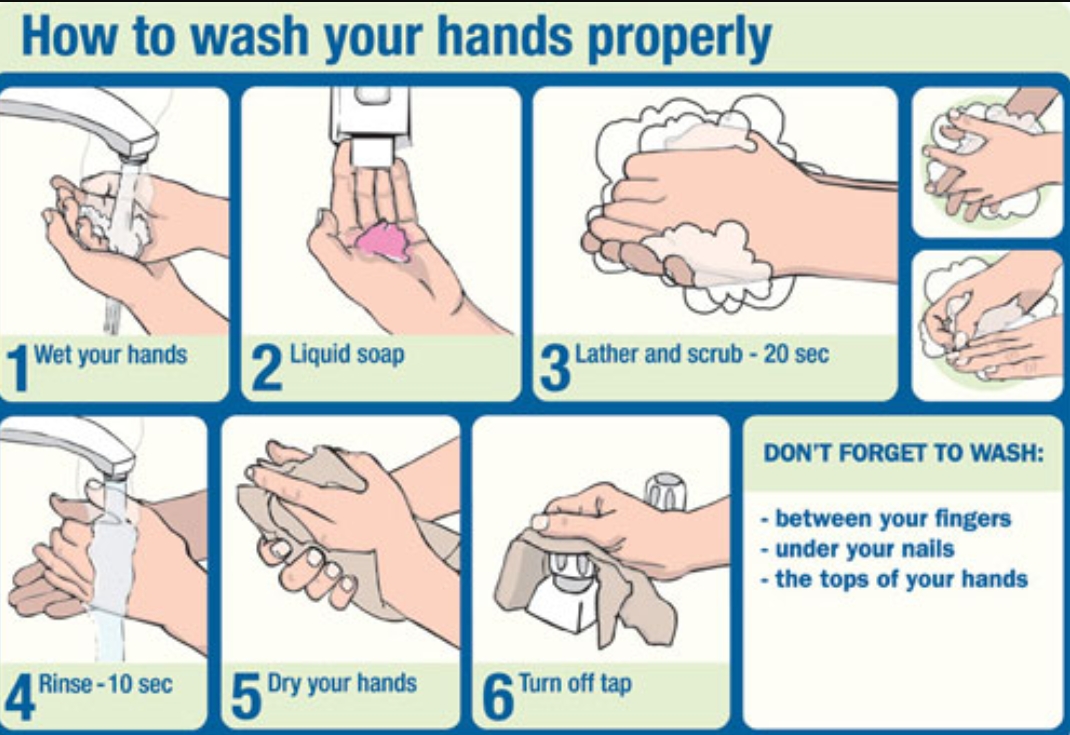Hygiene has long-established links with public health, but was not included in any MDG targets or indicators. The explicit reference to hygiene in the text of SDG target 6.2 represents increasing recognition of the importance of hygiene and its close links with sanitation. Of the range of hygiene behaviours considered important for health, hand washing with soap is a top priority in all settings. Access to basic facilities for menstrual hygiene management is critically important for women’s health, safety and dignity and can be monitored in institutional settings including schools and health facilities.
Good hygiene is an important barrier to many infectious diseases, including the faecal–oral diseases, and it promotes better health and well-being. To achieve the greatest health benefits, improvements in hygiene should be made concurrently with improvements in the water supply and sanitation, and be integrated with other interventions, such as improving nutrition and increasing incomes. The next sections discuss how to improve personal and community hygiene practices that help to prevent the spread of faecal–oral diseases. If wastewater is not disposed of effectively it can serve as a breeding ground for mosquitoes. People may also slip and fall in muddy puddles, and children may play in them and risk waterborne illness.
Personal and domestic hygiene
Handwashing
Hand washing, also known as hand hygiene, is the act of cleaning hands for the purpose of removing soil, dirt, and microorganisms. If water and soap is not available, hands can be cleaned with ash instead. Medical hand hygiene refers to hygiene practices related to medical procedures. Proper hand washing is one of the most effective ways of preventing the spread of diarrhoeal diseases. Pathogens cannot be seen on hands, and water alone is not always sufficient to remove them. Soap and wood ash are both cleansing and disinfecting agents when used with water and can be used to kill pathogens on hands and utensils. The most important times that hands should be washed with soap and water are:
- After defecating.
- After cleaning a child who has defecated.
- Before eating or handling food.
Promoting good personal hygiene often requires that community members are mobilized towards this goal and awareness is raised about how to achieve. It is important that hygiene education programmes do more than simply tell people that if they do not wash their hands they will become sick because of pathogens they cannot see. This rarely works. Instead, education programmes should try different methods to maximize community participation
Bathing
Bathing is the washing of the body with a liquid, usually water or an aqueous solution, or the immersion of the body in water. It may be practiced for personal hygiene, religious ritual or therapeutic purposes. .Regular bathing and laundering are important for cleanliness and good personal appearance. They also prevent hygiene-related diseases such as scabies, ringworm, trachoma, conjunctivitis and louse-borne typhus. Educational and promotional activities can encourage bathing and laundering, but increasing the number of washing facilities and locating them conveniently may be more effective. Bathing with soap is an important means of preventing the transmission of trachoma—an illness that can cause blindness and other eyesight problems. Children’s faces in particular should be washed regularly and thoroughly. If a child has trachoma, a special towel or tissue should be used to wipe or dry the child’s face; the towel should never be used for other children because of the risk of transmitting the disease. Ideally, programmes that promote bathing should be combined with a programme to reduce the numbers of flies, which spread trachoma and other diseases, and to improve sanitation.For people to bathe thoroughly they must use sufficient water, but it may be difficult to promote the use of more water for washing if water supplies are distant and water must be collected by hand. Moreover, many traditional bathing practices do not use water efficiently and ensuring cleanliness may be difficult. By modifying existing practices, such as by encouraging the use of water containers with taps, it may be possible to improve the efficiency of water use. Community shower units, with separate facilities for men and women, can also become income-generating enterprises in larger villages, but the facilities require careful maintenance and must be conveniently located.
.
Laundering
The fundamental difference between dry cleaning and laundering is water; dry-cleaning does not use water while laundering does. Most dry cleaners use chemical solvents like perchloroethylene (PERC) to get rid of stains like pen ink while the process of laundering uses gentler soaps and detergents. To promote laundering of clothes and bedding, laundry slabs or sinks can be constructed near water points. They should be large enough to wash bedding and other bulky items and be situated so that water drains away from the laundry area and away from the water source. Locating laundry places in natural water bodies, streams and irrigation canals is best avoided if possible, since this practice can contribute to the transmission of schistosomiasis.
Community hygiene
Some health measures can be undertaken only by the community as a whole; these include water source protection, proper disposal of solid waste and excreta, wastewater drainage, controlling animal rearing and market hygiene. Some of these issues have been described in earlier sections. Individual community members play an important role in community hygiene, and have a responsibility to their neighbours and to the community to promote good health and a clean environment. For example, everyone in the village must keep their houses and compounds clean, because one dirty house can affect many conscientious neighbours and contribute to the spread of disease. Community leaders can promote cleanliness in the home by regularly checking on village households and by using by-laws to encourage household maintenance.
Promoting Hygiene in the Markets
Markets often represent a health hazard because foodstuffs may not be stored properly and because the markets may lack basic services, such as water supply, sanitation, solid waste disposal and drainage. Ideally, markets should have several taps to provide traders and customers with ready access to safe water for drinking and washing. Many vegetable and fruit sellers regularly sprinkle their produce with water, and it is important that they have access to clean water for this. The sanitation facilities should also be appropriate for the number of people who will visit the market, with separate facilities for men and women. Water and sanitation facilities for a market are often relatively easy to support by charging a small user fee, or by using part of the market fee to pay for such services. If people are charged a fee to use the facilities, discounts can be offered to traders who already support the facilities through their market fee.
Foodstuffs sold at the market should be inspected daily by health officials. This is particularly important for meat and fish, which should be inspected before sale to ensure that they have been prepared according to national regulations and that they do not contain pathogens or other contaminants.
Markets usually generate a lot of solid waste and it is important that it is disposed of properly, to prevent vermin such as rats and insects from feeding and breeding among it. The layout of market stalls should thus allow easy access for vehicles that collect waste and clean the area. Solid waste should be collected and disposed of daily, and preferably more often. Strategically located waste bins (often concrete bunkers) can make this more effective. Market areas should also be properly drained to prevent flooding and insect breeding.
Animal rearing
In many communities animal rearing is a means of generating food high in protein content and nutritional value, and for generating additional income. Animals can also provide many other products, such as leather and fuel, that improve the quality of life. However, if it is not practised safely, animal rearing can have negative effects on the health of the community. Animals should always be kept away from households, particularly cooking areas and drinking-water sources, since their excreta contain pathogens that can contaminate food and water. Preferably, animals should be kept in compounds at least 100 metres from water sources and 10 metres from houses. Animal waste should be disposed of properly, away from homes and water sources, or be used as a fertilizer. It is also best that animals are slaughtered away from households and water sources, since the offal and wastes may introduce contamination. Slaughtering must be carried out by qualified individuals who follow the country laws governing slaughter practices.
Some disease vectors prefer animal hosts to humans. Pigs, for example, can be reservoirs of Japanese encephalitis, dogs can be reservoirs of leishmaniasis, and some mosquitoes prefer to feed on cattle rather than humans. Placing animal shelters between mosquito breeding places and the village may therefore provide some protection against malaria transmission.
Food hygiene
Food hygiene are the conditions and measures necessary to ensure the safety of food from production to consumption. Food can become contaminated at any point during slaughtering or harvesting, processing, storage, distribution, transportation and preparation. Contaminated food represents one of the greatest health risks to a population and is a leading cause of disease outbreaks and transmission. Food that is kept too long can go bad and contain toxic chemicals or pathogens, and foodstuffs that are eaten raw, such as fruits or vegetables, can become contaminated by dirty hands, unclean water or flies. Improperly prepared food can also cause chemical poisoning: cassava leaf that has not been properly pounded and cooked, for example, may contain dangerous levels of cyanide. To promote good health, therefore, food should be properly stored and prepared.
Food preparation in the home
As most food is likely to be prepared in the home, it is important that families understand the principles of basic hygiene and know how to prepare food safely. Before preparing food, hands should be washed with soap or ash. Raw fruit and vegetables should not be eaten unless they are first peeled or washed with clean water. It is also important to cook food properly, particularly meat. Both cattle and pigs host tapeworms that can be transferred to humans through improperly cooked meat; for this reason, raw meat should never be eaten. Eggs, too, must be cooked properly before eating, since they may contain salmonella, a virulent pathogen. The kitchen itself should be kept clean and waste food disposed of carefully to avoid attracting vermin, such as rats and mice, that may transmit disease. Keeping food preparation surfaces clean is critical, because harmful organisms can grow on these surfaces and contaminate food.
Fresh meat should be cooked and eaten on the same day, unless it can be stored in a refrigerator; if not, it should be thrown away. Cooked food should be eaten while it is still hot and should not be left to stand at room temperature for long periods of time, since this provides a good environment for pathogens to grow. Food that is ready to eat should be covered to keep off flies and should be thrown away if not eaten within 12–16 hours. If food must be stored after cooking, it should be kept covered and in a cool place, such as a refrigerator. If a refrigerator is not available,
food can be stored on ice blocks or in a preservative such as pickling vinegar or salt. Food that is already prepared, or food that is to be eaten raw, must not come into contact with raw meat as this may contain pathogens that can contaminate the other foods (particularly if slaughtering was not carried out hygienically).
Eating-houses
In many rural communities food is bought and consumed at eating-houses (cafes, restaurants or cantinas). If basic health and safety rules for storing, preparing and handling food are not followed in the eating-houses, these places will represent a health hazard for the customers and may cause serious disease outbreaks. The most important aspects of food hygiene in these establishments relate to sanitation, water supply and personal cleanliness:
- Eating-houses should have clean water for washing and drinking, and separate sanitation facilities, away from the kitchen area, for customers,cooks and food-handlers.
- The staff should have clean uniforms each day and have regular medical check-ups.
- Food should be freshly prepared daily and any that is spilled or not used should be disposed of.
- The kitchens and eating areas must be kept clean and free of vermin and insects.
- Eating-houses should also be well-ventilated, with adequate lighting, and have procedures for dealing with fires and accidents. For example, the eating area should not be too crowded, to allow customers easy exit in the event of a fire.
Most countries have legislation covering eating-houses and their operation. As a rule, eating-houses require official approval before they can operate and are subject to regular checks. These checks are likely to be increased in times of epidemics. The community should recognize that eating-houses must be properly run and maintained to ensure that they do not become a source of disease. Eating-houses should be periodically checked, for example by health officials, to make sure that the establishments do not pose health risks. If a community member suspects an eating-house of posing a health hazard, he/she should request an inspection by the appropriate local health authorities.
Street food-vendors
Street food-vendors are common in urban and periurban areas, but they also operate in rural areas, particularly if there is a market or community fair with bars and other drinking establishments. Although people enjoy food from these vendors, in many cases the food is of poor quality and it represents a serious health risk. A study in one African city, for example, found that 98% of the street vendors had faecal contamination on their hands and food, a situation that is likely to be the same for food vendors in other cities and villages. In part, this is because the street vendors have little or no access to safe water supplies or sanitation facilities, and they commonly cook and handle food with dirty hands. Raw foodstuffs, too,cannot be kept in safe storage places and are easily contaminated by vermin and insects.
Moreover, the street vendors often keep cooked food at ambient (environmental) temperatures for prolonged periods of time and may heat the food only slightly before serving. All these factors may make the food from street vendors dangerous.
Where street food-vendors are legal, they should be regulated by the health authorities. Often they are not legal, however, and in these cases steps should be taken to promote their safe management of food and, where necessary, to prevent them from selling their food. This may be difficult if the demand for street food is high, and it may be necessary to work closely with local health authorities. Street vendors should be encouraged to locate close to water points and sanitation facilities where they can keep hands and food clean. Community members can also work with vendors to ensure that food is prepared and eaten immediately, rather than being kept unrefrigerated for long periods.
Promoting nutrition
Nutrition is the science that interprets the interaction of nutrients and other substances in food in relation to maintenance, growth, reproduction, health and disease of an organism. It includes food intake, absorption, assimilation, biosynthesis, catabolism and excretion. A healthy and well-balanced diet is essential for good health. When there isnot enough food, or if the diet does not contain the right balance of foodstuffs, people become more prone to illness and may become undernourishedor malnourished. Children, in particular, are vulnerable to poor nutrition.Undernourishment and malnourishment can lower their resistance and make them more likely to suffer from infectious diseases. Often, children will eat only small amounts of food if it is spicy, even if it is nutritious, and it is important to make children’s food less spicy than adult food. Also, because their stomachs are small, children can eat only small portions and need to be fed more frequently than healthy adults. It is also important that children are fed not just foods high in starch or carbohydrate (for instance rice or cassava).Although these foods can quickly make a child feel full, he or she may become
malnourished if other key foodstuffs are not eaten. A well-balanced diet usually has a mixture of food with protein (for example beans, peas, meat, fish or eggs), carbohydrates (such as maize, potatoes, cassava, rice and many other staple foods), vitamins (such as vegetables, fish, fruits or milk), and some fats or oils (such as cooking oil). Sometimes not all these foods are available and it is important that community members ask health workers how to make best use of available foods for a balanced diet.
In many situations, nutrition can be improved by changing agricultural or gardening practices. Often, even small plots of land can provide nutritious food provided that the right crops are grown. Health workers or agricultural extension workers can be asked for advice about which crops to grow to provide community members with well-balanced diets. It is not possible here to give a full discussion of the nutritional value of foods, or of what constitutes a well-balanced diet. This is an enormous subject and is covered in more detail in materials developed by other programmes and organizations.However, it is important that communities request advice and support for improving nutrition. Many organizations provide advice and support for nutrition programmes





